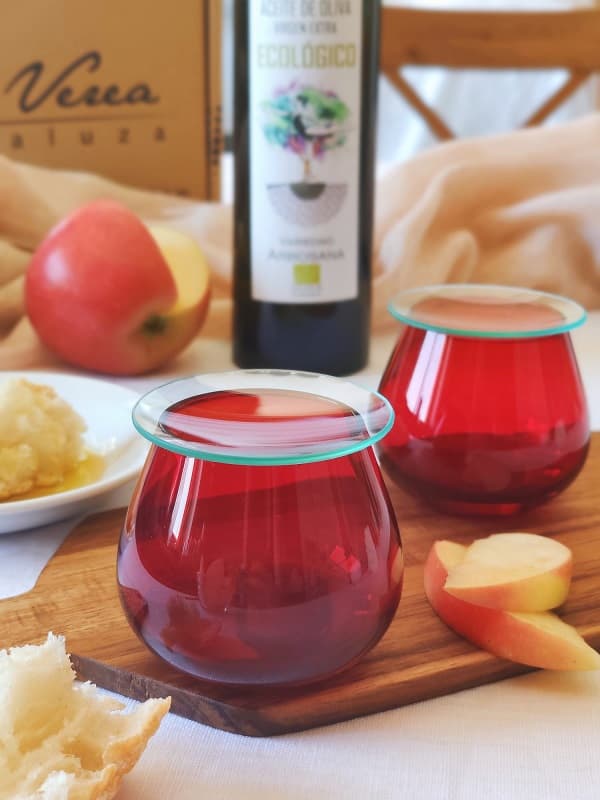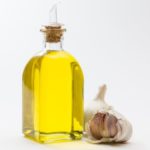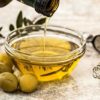This post is also available in:
Español (Spanish)
Nederlands (Dutch)
Français (French)
Deutsch (German)
Português (Portuguese (Portugal))
Olive oil is a product that has different types of quality. Therefore, in order to differentiate it, it has to go through a series of processes to evaluate its quality. Although the quality of olive oil depends on the quality of the olive and its processing in the milling process, it must also undergo other processes, such as a chemical study or the EOVE tasting. If only a chemical study is carried out, it will not be possible to define the exact flavour. Therefore, this is followed by the Olive Oil Tasting, in which experts on EVOO taste the product in order to clarify its taste, smell and flavour. For this tasting, there are specific materials to do so, such as the EOVE tasting glasses, which we will talk about next.
What should EVOO tasting glasses be like?
.
The EOVE tasting glasses are blue instead of transparent, as this allows the colour of the Extra Virgin Olive Oil to be indistinguishable. This is important, because the colour is not a necessary characteristic to assess the quality of the oil, but it does have to do with the person’s taste. The colour of EVOO depends on the olive that has been harvested, therefore, being dark avoids any prejudice.
Besides the colour, the creation of the copes for oil tasting takes into account three other aspects, which we will list below:
1. The material of the glass 2.
2. The fitting of the glass to the hand.
3. The accumulation of the olive oil aromatics inside.
The material of the glass must be made of resistant glass and the rim must be regular, smooth and rounded. The shape must be perfect, without irregularities.
The shape of the glass, wide at the bottom, is so that it does not tip over, and also so that the Extra Virgin Olive Oil can be warmed up when surrounding the glass with the hand. The mouth has to be narrower to allow a better identification of smells.
What is the so-called “Clock glass”
?
The glasses are accompanied by a clear glass lid, called “Clock glass”, to avoid loss of aroma and the entry of dust. This lid must be 10 mm larger than the mouth of the glass.
Can EVOO tasting glasses be any other colour than blue?
.
In 2017 the COI (International Olive Council), certified the red cup developed by the University of Jaén and the company Elaia Zait. The director of the project and professor of Immunology at the UJA, José Juan Gaforio, says that the red cup has a number of advantages over the blue ones, as it does not completely cancel out the colour of the oil.
Olive Oil Tasting Process
.
Elements to take into account
.
As mentioned above, the EVOO tasting process is compulsory before labelling. In order to carry out this organoleptic analysis, first of all we have to take into account a series of essential elements, such as:
- Room to carry out the tasting. It must be a room insulated from odours, soundproofed and with a temperature between 20 and 25ºC. In addition, the atmosphere should be quiet, so that there is greater concentration. The room is divided into individual booths for each taster. Lighting is also included in the regulations.
- Dark glass cup. With the characteristics we have seen above.
- Dark glass cup.
- Professional taster. They will be qualified people, and there will be between 8 and 12 expert tasters.
Steps of the Olive Oil Tasting
.
Once we have the necessary elements, we proceed to carry out the process, which will be organised by a series of steps.
- Pour 25 ml of Extra Virgin Olive Oil into a glass. Ideally it should be poured into the official glass, however, if you don’t have one, you can pour it into a normal wine glass.
- Pour the oil into a glass.
- Hold the glass with one hand, and with the other cover it (or you can also do it with the lid of the glass). Once you have done this, tilt the cup gently and turn it, so that the walls of the cup are impregnated with the product, and a larger surface area of air/oil contact is achieved.
- Next, uncap the glass, and proceed to the first phase of olfaction. Place the cup quickly to your nose, and inhale slowly and prolonged, trying to relate the smell with known fragrances.
- Once you have smelled it, give it a sniff with a small amount of oil. While the oil is in your mouth, suck air through your mouth and pass it between your teeth. This distinguishes the retronasal aromas, and also volatilises all the aromas of the oil.
- Again, take another small sip of oil, so as to identify the taste and sensations. Here you will notice whether the oil is sweet or not.
- After this, you will perceive a bitter and spicy taste on the back of the tongue and on the palate. The moderate spiciness and bitterness will tell you whether the oil is a quality oil or not.
- Now, it is time to evaluate the aromas that you have perceived in the oil tasting. If the aromas and flavours you have noticed are related to the lively and fresh nature, it means that the AOVE is complex.
- If the aromas and flavours you have noticed are related to the lively and fresh nature, it means that the AOVE is complex.
- Finally, think and remember everything you have tasted and noticed when tasting the oil, and evaluate it as a whole. The Oil is positive if the attributes it contains are fruity, spicy and bitter. The Extra Virgin Oils are reminiscent of fruits, vegetables and aromatic plants.
.
How is EVOO heated?
?
The EVOO is heated in an aluminium stove immersed in a thermostatically controlled water bath for better tasting. The temperature of the Oil should be 28º C (two degrees above or below).
How to cleanse the palate between different types of oil
.
Usually apple or breadsticks are used to cleanse the palate and restore it. Breadsticks are also commonly used in wine or cheese tastings. So don’t hesitate, before a tasting choose some good breadsticks without any additives.
Cleaning the EVOO tasting glass
.
Regarding the cleaning of the cup, it must be taken into account that this must be done without detergent or a small amount of neutral detergent.
Ecological oil La Verea Andaluza
.
Our Organic Extra Virgin Olive Oil extracted from Arbosana olives from our family farm is balanced in the mouth, with persistent sweet, delicately bitter and spicy flavours of medium intensity. The aroma is fruity, recalling scents such as freshly cut grass, almond, tomato, nuts, banana or artichoke.
We would like to thank amantier for the photographs taken with such merit.









